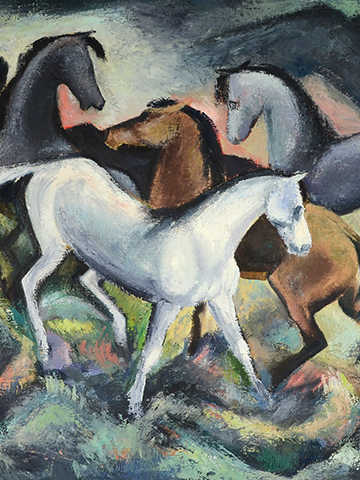The shows feature WSU art instructor Andrew Hofmeister and Seattle pictorialist photographer Yukio Morinaga.
Originally published by the Everett Herald, written by Gale Fiege. Published July 11, 2019
EDMONDS — Hey, all you Cougs!
A brilliant exhibit of paintings by the late Washington State University art instructor Andrew Hofmeister opens today at Cascadia Art Museum. If you love the Palouse and Pullman, you won’t want to miss it.
In addition, Cascadia now is showing photographs by once-world-famous Seattle pictorialist photographer Yukio Morinaga. If you like dreamy black-and-white images of old Seattle, this exhibit is for you.
“Paintings from the Palouse: The Art of Andrew L. Hofmeister (1913-2007)” and “Quiet Hour: The Photography of Yukio Morinaga (1888-1968)” are displayed through Oct. 13. Continuing exhibits are “Portraits and Self-Portraits by Northwest Artists” and part three of “Northwest Sculpture: Five Decades of Form and Innovation,” which are on view through Sept. 29.
Summer is a great time to visit this Edmonds museum. A beautiful garden blooms outside. Next-door and nearby restaurants have outdoor dining. And the beach is only a block away.
Hofmeister was an artist and instructor at WSU from 1947 to 1978. He earned his master of fine arts degree in Pullman and then stayed on to teach. The paintings exhibited are representative of all 50 of his years working in the Palouse and are on loan from the Hofmeister family.
His work is in the permanent collections of the Tacoma Art Museum, Seattle Art Museum, Museum of Northwest Art and the WSU and University of Montana art museums.
He was inspired by the landscape, his Montana upbringing, his love of horses, Western artist Charles M. Russell and the work of European modernists and West Coast Native American artists.
Hofmeister exhibited nationally and regionally, and was an especially well-known prize winner in the Northwest Watercolor Society. In Seattle, Hofmeister was represented by the Otto Seligman Gallery, which also represented Northwest master Mark Tobey.
His work involves styles that include cubism, surrealism and realism. Look for his paintings that involve animal and human figures in works that seem inspired by Tobey’s “white writing” style.
Cascadia curator David Martin always takes the extra step in curating his exhibits. For the Hofmeister show, he borrowed a mid-century modern dining room chair that Hofmeister made for his family, as well as a scrapbook, which quotes famous Seattle painter sculptor George Tsutakawa.
Tsutakawa called Hofmeister “a true Northwest artist” who often worked in watercolor, “the most difficult of mediums” to render art that is “warm, coherent and poetic.”
Some of my favorite paintings in the exhibit include those of logging and sheep-shearing operations, a county fair, Native Americans fishing on the Columbia River, and the spring-green wheat in the Palouse hills. His abstracts are powerful and engaging.
Also look for the photographic portrait of Hofmeister made by the great Edmonds photographer Mary Randlett, who died this January at 94.
“Andrew Hofmeister’s work is beautiful,” curator Martin said. “We have arranged it, not chronologically, but by what pairs well. He continued to practice various styles until his death.”
Morinaga was born in Japan, studied at Eastman School of Photography in New York, and then moved to Seattle in the 1920s.
Cascadia’s is the first solo exhibition of the work of this Northwest photographer, whose story is both inspiring and sad.
A distinguished member of the Seattle Camera Club, Morinaga produced an important body of work that displays elements of both pictorialism and modernism, Martin said.
He had a small studio in the International District of Seattle and was befriended by photographer Virna Haffer and her family.
Look for his painterly shots of water lilies, city lights and a beach scene — photos that were at one time shown all over the world, Martin said. Equally lovely are his pictures of King Street Station, the Smith Tower, the waterfront and early street photography that wasn’t really popular until the 1950s.
Nearly 30 of his vintage prints from the 1920s are displayed, as well as some artifacts that include two walking sticks that he hand-carved while interned at the Minidoka Relocation Center during World War II when West Coast people of Japanese ancestry were removed from their homes.
While in the Idaho concentration camp, Morinaga was not allowed to take photos. He seems to have lost heart during those years and never fully recovered, eventually starving himself to death. Look for his Christmas card to Haffer and the quote from her son Gene Randall about a visit to see Morinaga:
“We held his hand through the barbed wire fence when we visited him in the camps. We all cried. He was part of our family.”
You can find the original article here: https://www.heraldnet.com/life/visions-of-the-palouse-and-prewar-seattle-at-the-cascadia/


